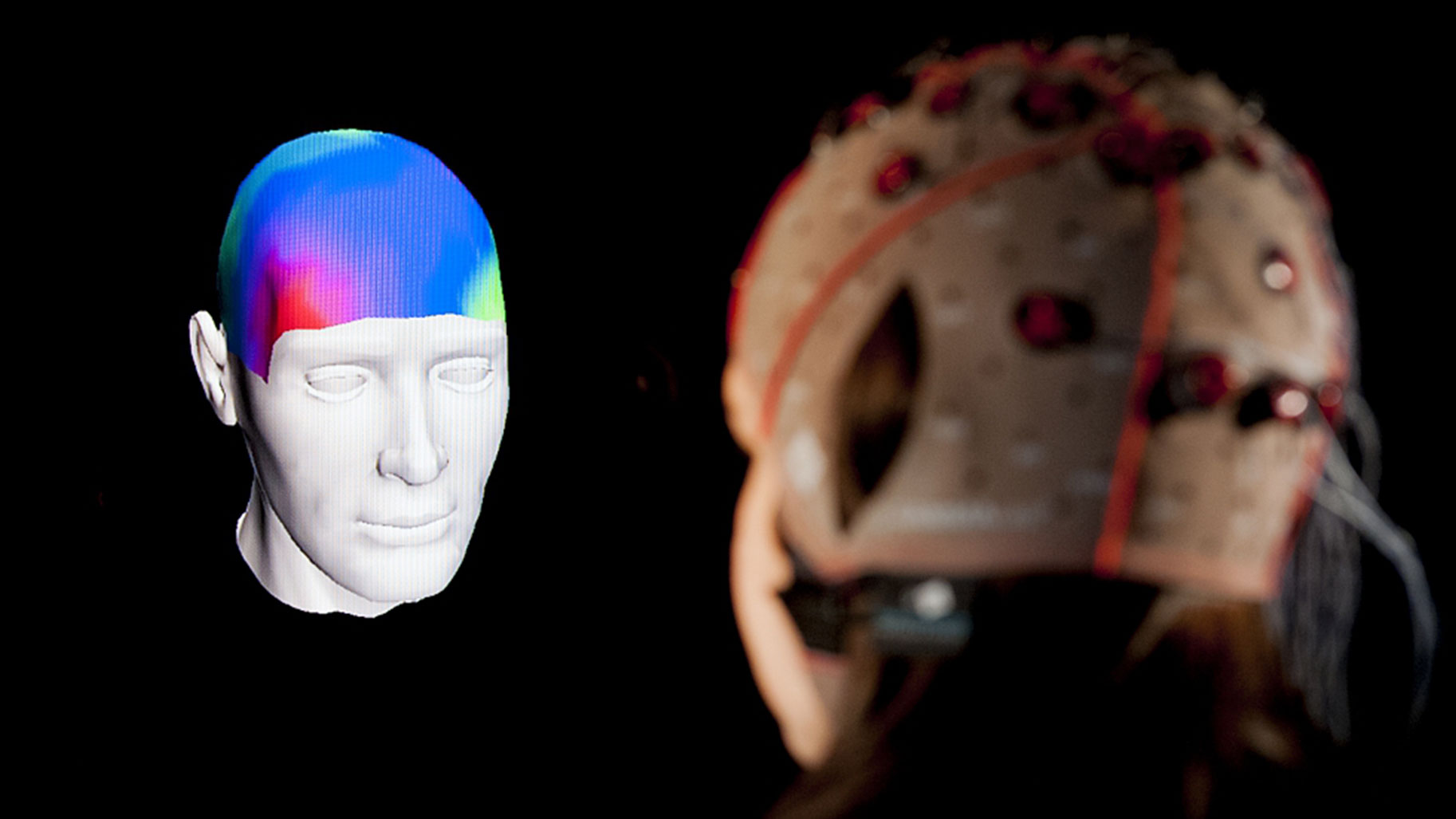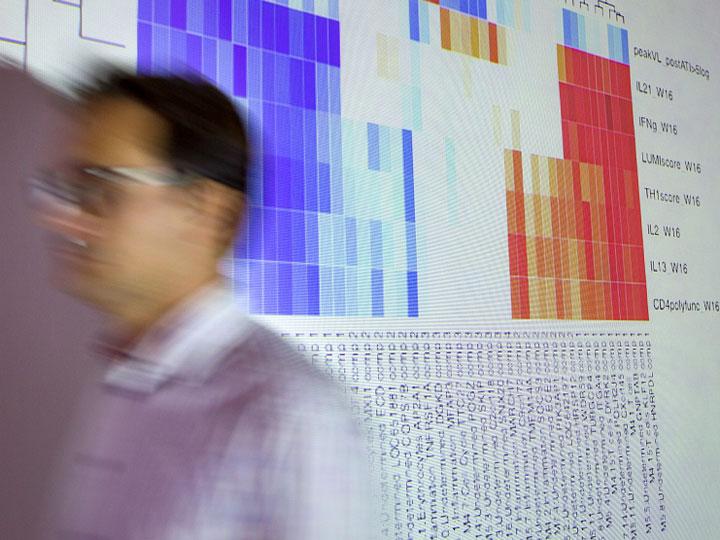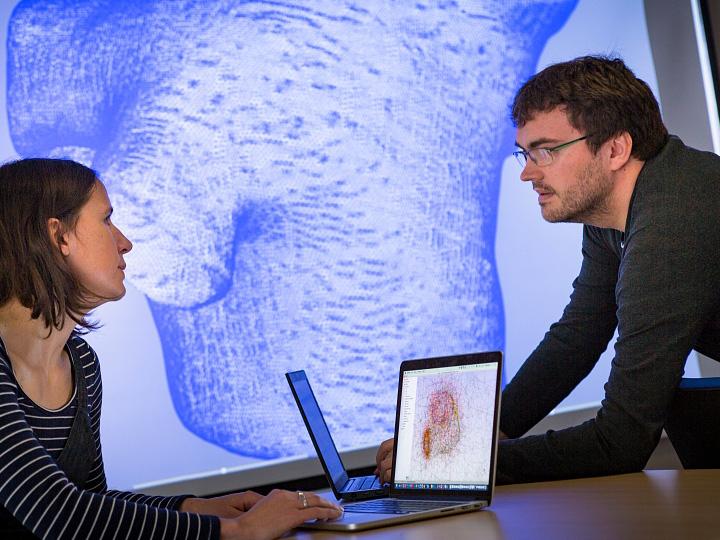
Protecting and screening: how does digital technology affect prevention?
By facilitating access to new, multidimensional and complex scientific data and formalizing processes, digital researchers support preventive medicine by participating alongside healthcare professionals in the questioning needed to consolidate the knowledge base in medical sciences.
Digital and immunology
Following the 2014 Ebola epidemic in West Africa, declared an international emergency by the WHO, the Sistm team shared by Inserm, the University of Bordeaux and Inria, has been working to develop a European Ebola vaccine since 2015. It is working on a number of issues: tolerance, vaccine efficacy and the optimization of an injection schedule. Rodolphe Thiébaut, head of the Sistm project team, explains: "To model the dynamics of the immune response to the vaccine candidate, we use systems of differential equations. Using data from clinical research, we can predict the quality and duration of the immune response to the vaccine in a given population".
The Pleiade project-team, specialized in digital biology, is particularly interested in the functioning of microorganisms in the intestinal microbiota, using statistical learning and metabolic network modeling approaches. This work enables us to develop new hypotheses on the role and assembly of micro-organisms, and the interactions between them, particularly in the event of disturbances to the microbial ecosystem. The team is also working on the design of future digital tools that will ultimately be useful to industry for the development of biotherapies.
Verbatim
The intestinal microbiota is a fascinating subject. We are seeking to better understand the dynamics of Salmonella Typhimurium infection using numerical models of the bacteria and the human host. We are also studying the role of microorganisms in the degradation of dietary fiber and the assembly of hundreds of bacterial populations in humans using massive DNA sequencing data.
Research associate in the Pleiade project-team
Digital technology and mental well-being
Inria is participating, through the involvement of two project-teams (Flowers and Potioc) in the creation of the Cerebral Vascular Health Institute in Bordeaux, which focuses on vascular "aging well" in the brain. Their objective? To develop new digital methodologies to decipher the mechanisms of the most common neurological diseases (stroke, dementia) in order to define management and prevention strategies. The most frequent consequence of a stroke is hemiparesis [1], which affects around 80% of patients acutely. Brain-computer interfaces (BCIs) have shown promising results, albeit unevenly depending on the individual. The Potioc team is attempting to individualize the BCI-based motor rehabilitation program to suit each patient, notably by personalizing the artificial intelligence (AI) models used.
Verbatim
New non-pharmacological digital therapies are thus being developed and tested, such as cognitive interventions optimized by machine learning to personalize the process according to each person's needs.
Professor of Psychology and Cognitive Science, Flowers project-team
From diagnosis to treatment: Decision support and optimized care pathways
Because the contribution of digital sciences is not limited to the general understanding of a pathology (screening/protection), but also accelerates the process of innovation in medical and clinical practices: two inseparable and complementary approaches.
A digital twin for better heart care
Cardiovascular disease is the leading cause of death worldwide (OM 2020). It is estimated that half of these deaths are linked to cardiac arrhythmias, such as ventricular fibrillation. For cardiologists, a better understanding of these dysfunctions and the ability to pinpoint the precise location of the problem is therefore of paramount importance. This is where digital science comes into play, thanks in particular to the "Digital Heart Twin". This "digital replica" measures and collects cardiovascular data, combining it with other data, such as medical imaging data, to provide a tool for clinical decision-making. It's a challenge that is close to the heart of the Carmen team, part of the LIRYC IHU: "As scientists, we can provide either decision-making tools or scientific elements that will help us understand a complex biological system. We therefore need both statistical data and models in the mechanistic (physical) sense to cover these two approaches", explains Yves Coudière, head of the Carmen project-team.
Using digital technology to develop non-invasive therapies
The Cagire project-team is interested in gaining a better understanding of the physics involved in the interactions between bubbles and biomaterials, with the aim of improving current medical treatments. In terms of applications, the team is working in particular on lithotripsy [2] , a procedure designed to use non-surgical methods to treat kidney stones that are too large to be removed via the urinary tract, thus avoiding cumbersome and painful surgical procedures for patients. The use of digital technology offers a clear advantage in understanding the physical mechanisms involved in the fragmentation of kidney stones by ultrasonic shock waves, such as wave propagation and cavitation phenomena, which are extremely difficult to observe by experiment alone.
Verbatim
This contributes to the improvement of existing non-invasive technologies, such as those using shock waves, while assessing the potential benefits of new technologies, including those using high-intensity focused ultrasoun.
Researcher in the Cagire project-team
Digital tools for personalized cancer treatment
The Monc project-team is seeking to build digital tools based on partial differential equations and learning methods to better understand, monitor or treat certain cancers. "For tumor ablation by electroporation [3] , the problem is to provide the interventional radiologist with the ablation zone calculated on the basis of the procedure data, right from the start, so that treatment can be adjusted (repositioning needles, increasing amplitude, etc.)" explains Clair Poignard, head of the Monc team. To achieve this, the scientists use biological and medical knowledge as well as digital data (mostly from imaging) to personalize the models. The aim is to be able to provide physicians and biologists with digital tools to better understand, predict and even control tumor growth, and to better evaluate the response of the disease to a treatment in a clinical context or during preclinical studies.
Verbatim
At the same time, although part of our research activity is highly applied "with patients on the operating table", we are keen to maintain a continuum between theoretical and applied research. Close collaboration with biologists and physicians is also essential to our research.
Head of the Monc project-team
Pour aller plus loin :

Désassemblons le numérique
[1] Hemiparesis is a loss of muscle strength in the contralateral upper limb, of which more than 80% is acute and more than 40% chronic in stroke patients.
[2] Lithotripsy treats kidney stones by applying focused ultrasonic energy or shock waves directly to the localized stone using fluoroscopy (an X-ray "film") or ultrasound (high-frequency sound waves). The shockwaves then fragment the large stone for urinary evacuation.
[3] Electroporation is a microbiological technique in which an electric field is applied to cell membranes, destabilizing them and increasing membrane permeability.

